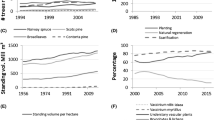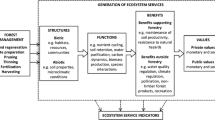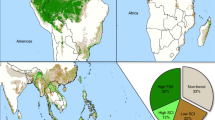Abstract
A multi-scaled model for biodiversity conservation in forests was introduced in Sweden 30 years ago, which makes it a pioneer example of an integrated ecosystem approach. Trees are set aside for biodiversity purposes at multiple scale levels varying from individual trees to areas of thousands of hectares, with landowner responsibility at the lowest level and with increasing state involvement at higher levels. Ecological theory supports the multi-scaled approach, and retention efforts at every harvest occasion stimulate landowners’ interest in conservation. We argue that the model has large advantages but that in a future with intensified forestry and global warming, development based on more progressive thinking is necessary to maintain and increase biodiversity. Suggestions for the future include joint planning for several forest owners, consideration of cost-effectiveness, accepting opportunistic work models, adjusting retention levels to stand and landscape composition, introduction of temporary reserves, creation of “receiver habitats” for species escaping climate change, and protection of young forests.






Similar content being viewed by others
References
Aubry, K.B., C.B. Halpern, and D.A. Maguire. 2004. Ecological effects of variable-retention harvests in the northwestern United States: The DEMO study. Forest Snow and Landscape Research 78: 119–137.
Babcock, B.A., P.G. Lakshminarayan, J. Wu, and D. Zilberman. 1997. Targeting tools for the purchase of environmental amenities. Land Economics 73: 325–339.
Baker, S.C., S.J. Grove, L. Forster, K.J. Bonham, and D. Bashford. 2009. Short-term responses of ground-active beetles to alternative silvicultural systems in the Warra Silvicultural Systems Trial, Tasmania, Australia. Forest Ecology and Management 258: 444–459.
Bengtsson, J., P. Angelstam, T. Elmqvist, U. Emanuelsson, C. Folke, M. Ihse, F. Moberg, and M. Nyström. 2003. Reserves, resilience and dynamic landscapes. Ambio 32: 389–396.
Bergh, J., S. Linder, and J. Bergström. 2005. Potential production of Norway spruce in Sweden. Forest Ecology and Management 204: 1–10.
Berglund, H., and B.G. Jonsson. 2004. Verifying an extinction debt among lichens and fungi in northern Swedish boreal forests. Conservation Biology 19: 338–348.
Elton, C. 1927. Animal ecology. London, England: Sidgwick and Jackson, 207 pp.
Esseen, P.-A., K.-E. Renhorn, and R.B. Pettersson. 1996. Epiphytic lichen biomass in managed and old-growth forests: Effect of branch quality. Ecological Applications 6: 228–238.
Fahrig, L. 2001. How much habitat is enough? Biological Conservation 100: 65–74.
Ferraro, P.J. 2003. Assigning priority to environmental policy interventions in a heterogeneous world. Journal of Policy Analysis and Management 22: 27–43.
Fimbel, R.A., A. Grajal, and J.G. Robinson, eds. 2001. The cutting edge. Conserving wildlife in logged tropical forests. New York: Columbia University Press, 808 pp.
Franklin, J.F. 1989. Towards a new forestry. American Forests 95: 37–44.
Fridman, J. 2000. Conservation of forests in Sweden: A strategic ecological analysis. Biological Conservation 96: 95–103.
Gustafsson, L. 2002. Presence and abundance of red-listed plant species in Swedish forests. Conservation Biology 16: 377–388.
Gustafsson, L., A. Dahlberg, M. Green, S. Henningsson, C. Hägerhäll, A. Larsson, Å. Lindelöw, A. Lindhagen, G. Lundh, Å. Ode, T. Ranius, J. Sandström, J. Strengbom, R. Svensson, and O. Widenfalk. 2010. Konsekvenser för kulturarv, friluftsliv, landskapsbild och biologisk mångfald. Faktaunderlag till MINT-utredningen. SLU Rapport. Uppsala, 208 pp. (in Swedish).
Hottola, J., and J. Siitonen. 2007. Significance of woodland key habitats for polypore diversity and red-listed species in boreal forests. Biodiversity and Conservation 17: 2559–2577.
Hutchinson, G.E. 1978. An introduction to population ecology. New Haven, Connecticut, USA: Yale University Press, 256 pp.
Jönsson, M.T., S. Fraver, B.G. Jonsson, M. Dynesius, M. Rydgård, and P.-A. Esseen. 2007. Eighteen years of tree mortality and structural change in an experimentally fragmented Norway spruce forest. Forest Ecology and Management 242: 306–313.
Junninen, K., and J. Kouki. 2006. Are woodland key habitats in Finland hotspots for polypores (Basidiomycota)? Scandinavian Journal of Forest Research 21: 32–40.
Junninen, K., M. Similä, J. Kouki, and H. Kotiranta. 2006. Assemblages of wood-inhabiting fungi along the gradients of succession and naturalness in boreal pine-dominated forests in Fennoscandia. Ecography 29: 75–83.
Kaila, L., P. Martikainen, and P. Punttila. 1997. Dead trees left in clear-cuts benefit saproxylic Coleoptera adapted to natural disturbances in boreal forests. Biodiversity and Conservation 6: 1–18.
Karlsson, J., H. Brøseth, H. Sand, and H. Andrén. 2007. Predicting occurrence of wolf territories in Scandinavia. Journal of Zoology 272: 276–283.
Knight, A., and R.M. Cowling. 2007. Embracing opportunism in the selection of priority conservation areas. Conservation Biology 21: 1124–1126.
Kuuluvainen, T. 2002. Natural variability of forests as a reference for restoring and managing biological diversity in boreal Fennoscandia. Silva Fennica 36: 97–125.
Larsson, S., T. Lundmark, and G. Ståhl. 2009. Möjligheter till intensivodling av skog. Slutrapport från regeringsuppdrag Jo 2008/1885. Uppsala: Sveriges lantbruksuniversitet, 136 pp. (in Swedish).
Lazdinis, M., P. Angelstam, and I. Lazdinis. 2007. Maintenance of forest biodiversity in a post-Soviet governance model: Perceptions by local actors in Lithuania. Environmental Management 40: 20–33.
Lindenmayer, D.B., J.F. Franklin, and J. Fischer. 2006. General management principles and checklists of strategies to guide forest biodiversity conservation. Biological Conservation 131: 433–445.
Lindhe, A., N. Åsenblad, and H.-G. Toresson. 2004. Cut logs and high stumps of spruce, birch, aspen and oak—nine years of saproxylic fungi succession. Biological Conservation 119: 443–454.
Lindhe, A., and Å. Lindelöw. 2004. Cut high stumps of spruce, birch, aspen and oak as breeding substrates for saproxylic beetles. Forest Ecology and Management 203: 1–20.
Lõhmus, A., and P. Lõhmus. 2010. Epiphyte communities on the trunks of retention trees stabilise in 5 years after timber harvesting, but remain threatened due to tree loss. Biological Conservation 143: 891–898.
Martínez Pastur, G., M.V. Lencinas, J.M. Cellini, P.L. Peri, and R.S. Esteban. 2009. Timber management with variable retention in Nothofagus pumilio forests of Southern Patagonia. Forest Ecology and Management 258: 436–443.
Mather, A. 1992. The forest transition. Area 24: 367–379.
Matveinen-Huju, K., J. Niemelä, H. Rita, and R.B. O’Hara. 2006. Retention-tree groups in clear-cuts: Do they constitute ‘life-boats’ for spiders and carabids? Forest Ecology and Management 230: 119–135.
May, R., A. Landa, J. van Dijk, J.D.C. Linnell, and R. Andersen. 2006. Impact of infrastructure on habitat selection of wolverines Gulo gulo. Wildlife Biology 12: 285–295.
McGeoch, M.A., M. Schroeder, B. Ekbom, and S. Larsson. 2007. Saproxylic beetle diversity in a managed boreal forest: Importance of stand characteristics and forestry conservation measures. Diversity and Distributions 13: 418–429.
Millennium Ecosystem Assessment. 2005. Ecosystems and Human Well-being: Biodiversity Synthesis. Washington, DC: World Resources Institute, 86 pp.
Naidoo, R., A. Balmford, P.J. Ferraro, S. Polasky, T.H. Ricketts, and M. Rouget. 2006. Integrating economic costs into conservation planning. Trends in Ecology & Evolution 21: 681–687.
Noss, R.F., C. Carroll, K. Vance-Borland, and G. Wuerthner. 2002. A multicriteria assessment of the irreplaceability and vulnerability of sites in the Greater Yellowstone Ecosystem. Conservation Biology 16: 895–908.
Perhans, K., L. Appelgren, F. Jonsson, U. Nordin, B. Söderström, and L. Gustafsson. 2009. Retention patches as potential refugia for bryophytes and lichens in managed forest landscapes. Biological Conservation 142: 1125–1133.
Ranius, T., and O. Kindvall. 2006. Extinction risk of wood-living model species in forest landscapes as related to forest history and conservation strategy. Landscape Ecology 21: 687–698.
Rayfield, B., P.M.A. James, A. Fall, and M.J. Fortin. 2008. Comparing static versus dynamic protected areas in the Quebec boreal forest. Biological Conservation 141: 438–449.
Rosenvald, R., and A. Lõhmus. 2008. For what, when, and where is green-tree retention better than clear-cutting? A review of the biodiversity aspects. Biological Conservation 255: 1–15.
Rosenzweig, M.L. 1995. Species diversity in space and time. Cambridge; Cambridge University Press, 436 pp.
Scott, J.M., F.W. Davis, R.G. McGhie, R.G. Wright, C. Groves, and J. Estes. 2001. Nature reserves: Do they capture the full range of America’s biodiversity? Ecological Applications 11: 999–1007.
Sippola, A.-L., J. Siitonen, and P. Punttila. 2002. Beetle diversity in timberline forests: A comparison between old-growth and regeneration areas in Finnish Lapland. Annales Zoologici Fennici 39: 69–86.
Söderström, B. 2009. Effects of different levels of green- and dead-tree retention on hemi-boreal forest bird communities in Sweden. Forest Ecology and Management 257: 215–222.
Statens Offentliga Utredningar (SOU). 2006. Mervärdesskog. Del 1 Beslut och ställningstaganden. Slutbetänkande av skogsutredningen 2004. SOU 2006:81. Stockholm: Ministry of Agriculture, 371 pp. (in Swedish).
Statistics Sweden and Swedish Environmental Protection Agency. 2008. Protected nature 2007 (Skyddad natur 31 dec 2007). Statistiska Meddelanden MI 41 SM 0801. Stockholm: Statistics Sweden, 46 pp. (in Swedish).
Strange, N., C. Rahbek, J.K. Jepsen, and M. Lund. 2006. Using farmland prices to evaluate cost-efficiency of national versus regional reserve selection in Denmark. Biological Conservation 128: 455–466.
Sverdrup-Thygeson, A. 2002. Key habitats in the Norwegian production forest: A case study. Scandinavian Journal of Forest Research 17: 166–178.
Sverdrup-Thygeson, A., and T. Birkemoe. 2009. What window traps can tell us: Effect of placement, forest openness and beetle reproduction in retention trees. Journal of Insect Conservation 13: 183–191.
Swedish Forest Agency. 2008. Statistical yearbook of forestry 2008. Official statistics of Sweden. Jönköping: Swedish Forest Agency, 393 pp.
Swedish Forest Agency. 2009. Regler om användning av främmande trädslag. Meddelande 7. Swedish Forest Agency, Jönköping, 138 pp. (in Swedish).
Swedish Forest Agency and SLU. 2008. Skogliga konsekvensanalyser. SKA-VB 08. Rapport 25. Jönköping, 146 pp.
Thuiller, W., S. Lavorel, M.B. Araujo, M.T. Sykes, and I.C. Prentice. 2005. Climate change threats to plant diversity in Europe. Proceedings of the National Academy of Sciences of the United States of America 102: 8245–8250.
Toivanen, T., and J. Kotiaho. 2007. Burning of logged sites to protect beetles in managed boreal forests. Conservation Biology 21: 1562–1572.
Vanha-Majamaa, I., and J. Jalonen. 2001. Green tree retention in Fennoscandian forestry. Scandinavian Journal of Forest Research 16(suppl. 3): 79–90.
Whittaker, R.H. 1972. Evolution and measurement of species diversity. Taxon 21: 213–251.
Wikberg, S., K. Perhans, C. Kindstrand, L.B. Djupström, M. Boman, L. Mattsson, L.M. Schroeder, J. Weslien, and L. Gustafsson. 2009. Cost-effectiveness of implemented conservation strategies in boreal forests: The area selection process. Biological Conservation 142: 614–624.
Work, T.T., J.R. Spence, W.J.A. Volney, L.E. Morgantini, and J.L. Innes. 2003. Integrating biodiversity and forestry practices in western Canada. Forestry Chronicle 79: 906–916.
Acknowledgments
We are grateful to Jerry F. Franklin, Reed Noss, and Jan-Olov Weslien who kindly read and commented on the manuscript. Economic support was given by the Swedish Research Council Formas.
Author information
Authors and Affiliations
Corresponding author
Rights and permissions
About this article
Cite this article
Gustafsson, L., Perhans, K. Biodiversity Conservation in Swedish Forests: Ways Forward for a 30-Year-Old Multi-Scaled Approach. AMBIO 39, 546–554 (2010). https://doi.org/10.1007/s13280-010-0071-y
Received:
Revised:
Accepted:
Published:
Issue Date:
DOI: https://doi.org/10.1007/s13280-010-0071-y




